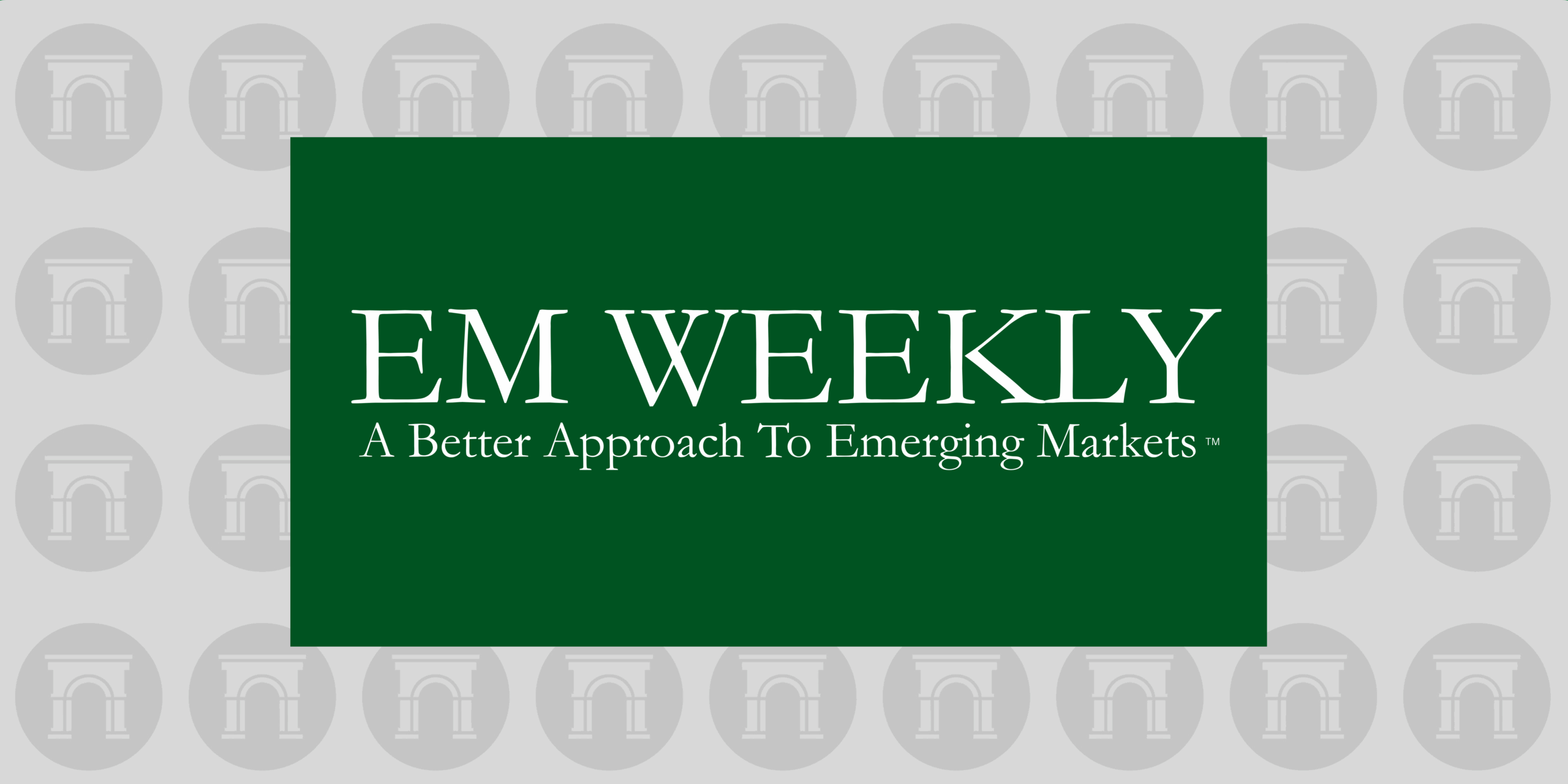Contents
Market Overview
Macro Update
This week ended with an escalation in geopolitical tensions after Israel initiated attacks on Iran, shifting the spotlight away from economic data and trade developments. Markets reacted with caution. Yet, away from the surge in oil prices, the overall response was relatively measured given the significance of the strikes. Gold rose amid “safe haven” flows that, in an historically unusual development, did not benefit yields on U.S. Treasuries. Indeed, yields ended higher as traders and investors were reminded of the geopolitical tail risks in the global macro landscape.
Earlier in the week, attention centered on the “trade framework” agreement between U.S. and Chinese negotiators in London. Initially viewed as a breakthrough – particularly in relation to China’s export restrictions on critical rare earth minerals – the lack of detail and continued absence of tariff rollbacks suggest this is a tactical pause rather than a strategic reset in the bilateral relationship. The economic significance of the agreement will hinge on implementation and the official positions of Presidents Donald Trump and Xi Jinping in the weeks ahead.
Focus also turned to the U.S. economy, with May’s inflation data coming in softer than expected across both consumer and producer levels. This suggests that for now, higher tariffs have not translated into price pressures, raising questions about the strength of demand and the pass-through of cost increases. Markets responded with a meaningful repricing of rate expectations; Fed funds futures currently reflect two full 25bps cuts in 2025, up from under one cut just a week ago. The week ended with the University of Michigan consumer sentiment survey showing the first consumer sentiment improvement this year: sentiment rose 8.3 points to 60.5 in June, exceeding expectations, as concerns about the economy and expectations of short-term inflation eased.
Equity markets finished the week in the red amid the Middle East military escalation but remain near record highs after posting some gains during the week on better economic data. U.S. Treasury yields trended lower across the curve but gave up some gains at the end of the week, closing at around 4.45% for the 10-year and 4.90% for the 30-year maturity.
After weakening notably during the week, the U.S. dollar staged a very modest recovery amid global geopolitical turmoil on Friday. It’s continued weakness raises significant questions about the validity of the “Dollar Smile” in the current global macro context. The DXY remained wrapped around its 98 three-year low, while EUR/USD broke through 1.15 for the first time since 2021. Commodities reflected this shifting mix of geopolitics and policy expectations. Gold gained further, to trade above $3,400/oz, while oil prices soared in tandem with tensions in the Middle East. Brent and WTI closed at around $75 and $73 per barrel, respectively, about 25% higher than a month ago.
Several other U.S. data releases this week attracted limited market attention. Wholesale inventories rose 0.2% month-over-month (vs. 0.0% expected), while initial jobless claims came in at 248,000 – slightly above expectations and flat to the prior week. The May federal budget deficit totalled $316 billion (vs. $347 billion last year), bringing the fiscal year-to-date shortfall to $1.365 trillion, up from $1.202 trillion a year ago and underscoring the steady drift in U.S. fiscal imbalances.
Internationally, China’s May CPI fell for the fourth consecutive month (-0.1% year-over-year), underscoring the persistent weakness in domestic demand. Producer prices declined 3.3% year-over-year, slightly more than forecast, as firms continue to cut prices to attract cautious consumers. Similar disinflationary trends were seen in Colombia, Brazil, and India, while inflation surprised to the upside in Mexico and Ukraine, reminders of the uneven post-pandemic normalization process across emerging markets.
In the UK, the economy contracted by 0.3% in April, the sharpest monthly decline since 2023. This was driven by weakness in industrial output and exports, as well as a notable rise in jobless claims. Japan offered a modest upside surprise, with final Q1 GDP revised to -0.2% quarter-over-quarter from -0.7%, while Saudi Arabia reported steady year-over-year growth of 3.4% in Q1, driven largely by non-oil sectors.
This week, politics shaped the macro landscape across key emerging markets. In Poland, Prime Minister Donald Tusk survived a confidence vote following a setback in the presidential election which reinforced, at least for now, the continuity of his pro-EU agenda. Pakistan unveiled an ambitious fiscal consolidation plan in its 2025-26 budget, featuring a 20% increase in defence spending offset by broad spending cuts. Markets will look for signs of credibility and execution. Meanwhile, Argentina’s Supreme Court upheld a corruption conviction against former President Cristina Fernández de Kirchner, barring her from politics for life, a move likely to be viewed by markets as strengthening President Javier Milei’s reform agenda. In Colombia, the shooting of presidential candidate Miguel Uribe and a series of explosions in the southwest have drawn renewed attention to the country’s internal dynamics, with authorities attributing both incidents to a FARC-dissident leader.
Lastly, the Russia–Ukraine conflict continued to escalate. Following last week’s deep strikes into Russian territory by Ukrainian forces, Moscow launched its largest aerial assault since the war began, another reminder of geopolitical fragilities.
EM Credit Update
EM hard currency sovereign debt posted a 0.8% gain for the week, with similar performance across both high-yield and investment-grade segments. However, spreads began to widen again. At the index level, spreads were 3bps wider, with investment grade widening by 5bps and high yield by 1bp.
Latin America led regional performance, with Ecuador among the top performers once again. The rally was supported by news that the IMF and Ecuadorian authorities reached a staff-level agreement on the second review under the Extended Fund Facility (EFF), unlocking approximately USD 400 million in disbursements.
Ukraine also surprised to the upside, emerging as a top performer despite the intensifying conflict, as this week’s gains offset last week’s underperformance. Conversely, Senegal was the weakest performer, with investor sentiment weighed down by concerns over fiscal credibility.
EM local currency sovereign debt also gained 0.8% this week, supported by continued softness in the U.S. dollar. Year-to-date, this segment remains a standout, returning 10.9%.
EM corporate debt underperformed sovereigns once again, posting a 0.5% return at the index level. Investment grade modestly outpaced high yield (0.6% vs. 0.4%), though spreads widened 6bps–7bps across both segments.
Primary market activity was concentrated in corporates, with ten new deals priced during the week, while sovereign issuance remained absent.
Note: All data is as of Thursday, as end-of-day pricing for Friday was not available at the time of publication. As such, the impact of Israel’s attack on Iran is not fully reflected in the figures. That said, the market reaction across EM has been relatively muted.
The Week Ahead
Next week features a flurry of rate-setting meetings by global central banks, including by three of the systemic ones – the Fed, Bank of England (BoE) and Bank of Japan (BoJ) – as well as those in Switzerland, Pakistan, Chile, Brazil, Indonesia, Sweden, Norway, the Philippines, Taiwan, and Türkiye. The FOMC is widely expected to leave the fed-funds target range unchanged at 4.50% (upper bound) and signal a continued “wait-and-see” approach.
The BoE’s policy meeting will be held against the backdrop of a sharp increase in UK unemployment claims and weakening, but still relatively elevated, wage growth. The consensus expects a hold at 4.25%. BoJ is also widely expected to hold at 0.50%. SNB, the Swiss National Bank, is expected to deliver a 25bps cut, to 0%.
May CPI data will be reported by Israel, Saudi Arabia, Italy, Nigeria, Poland, the eurozone, South Africa, UK, Hong Kong, and Japan. 1Q GDP numbers will be released by Israel, Sri Lanka, Russia, and New Zealand. Türkiye will publish its April current account balance. In addition to the FOMC decision, other notable U.S. macro data includes the Empire Manufacturing survey, retail sales, business inventories, import/export prices, industrial production, housing starts, initial jobless claims, and the Conference Board’s leading index. China will report retail sales, industrial production, and loan prime rates. Markets will also receive data on eurozone consumer confidence, German economic sentiment, and UK retail sales.
Beyond the economic data, a military parade will take place in Washington D.C. for the U.S. Army’s 250th anniversary, and the G7 Leaders’ Summit will be held in Canada from June 15th – 17th, marking the first major meeting of world leaders in President Trump’s second term. Separately, Chinese President Xi will visit Kazakhstan to meet President Kassym-Jomart Tokayev and discuss bilateral economic ties.
U.S. senators are expected to resume floor debate on the $3 trillion tax bill, facing a July 4th deadline set by the White House, which seems unlikely to be met. Euro area finance ministers meet in Luxembourg through June 20th, and the Lujiazui Forum will take place in Shanghai with a focus on China’s financial reforms. PBOC Governor Pan Gongsheng and other top regulators are expected to attend. In addition, the 75-day TikTok divest-or-ban period is set to expire, but the U.S. may extend it again.
Fixed Income
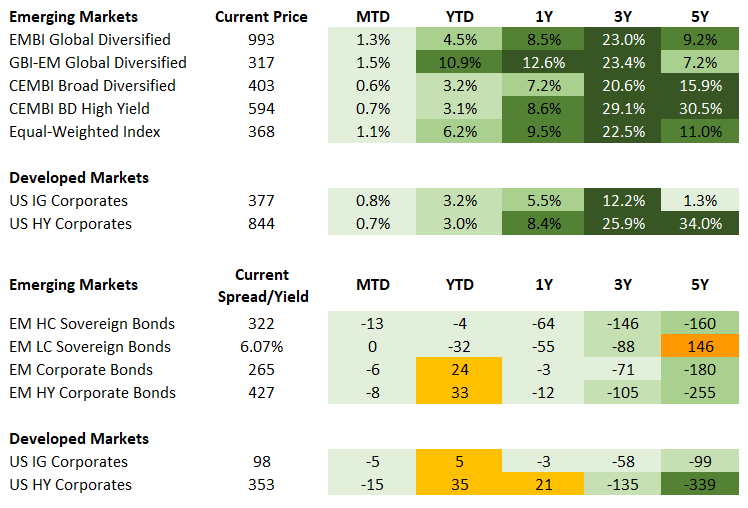
Equities
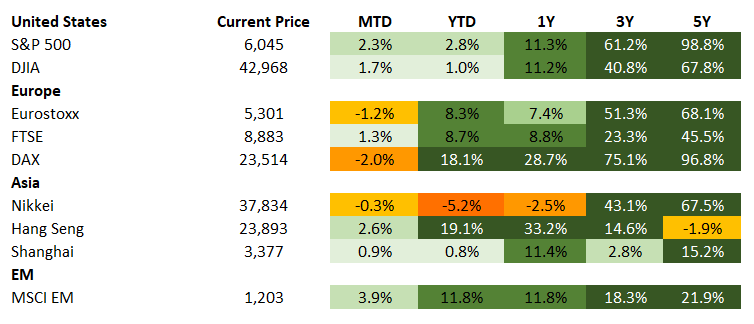
Commodities

Source for data tables: Bloomberg, JPMorgan, Gramercy. EM Fixed Income is represented by the following JPMorgan Indicies: EMBI Global, GBI-EM Global Diversified, CEMBI Broad Diversified and CEMBI Broad High Yield. DM Fixed Income is represented by the JPMorgan JULI Total Return Index and Domestic High Yield Index. Fixed Income, Equity and Commodity data is as of June 13, 2025 (mid-day).
Highlights
Assassination Attempt and Explosions Plunge Colombia into Turmoil
Event: Colombian presidential candidate Miguel Uribe, a conservative Senator and critic of incumbent, left-wing President Gustavo Petro, was shot in the head at a rally in Bogota on June 7th and remains in critical condition. The assassination attempt was followed by more than 20 explosions across southwest Colombia that left at least eight dead. Both attacks were blamed by the authorities on a warlord known as Iván Mordisco, a FARC-dissident guerrilla leader wielding significant influence over the Amazon regions of southern Colombia.
Gramercy Comment: The string of events, reminiscent of the violence that roiled Colombia in the 1980s and 1990s, has put the country’s already volatile political environment into further turmoil. Investigations are ongoing to determine more details about who ordered the attacks and their motive, while President Petro has pointed a finger at “the international mafia.” The escalation of violence comes amid mounting fiscal challenges under the Petro Administration following the approval of a three-year suspension of Colombia’s fiscal rule – a move that was opposed by the Fiscal Rule Committee, an oversight body required by law to issue a non-binding opinion.
Meanwhile, the Ministry of Finance announced a revision of the 2025 fiscal deficit target to 7.1% of GDP, from 5.1% previously. We think that the combination of political, economic, and fiscal deterioration is likely to continue to put pressure on Colombia’s sovereign debt valuation in the near term. However, we have a more constructive medium-term view, expecting that legislative and presidential elections, scheduled for March and May 2026 respectively, are likely to result in a more market-friendly administration. In our view, the recent developments have strengthened this prospect.
Ecuador Reaches Key Agreement with IMF
Event: Ecuador’s government and the IMF reached a staff level agreement on a set of comprehensive policies and reforms needed to complete the second review under the country’s Extended Fund Facility (EFF) arrangement. Amid a more challenging external environment, the Administration of President Daniel Noboa has also requested an increase of the original arrangement to $5 billion from $4 billion.
Gramercy Comment: This credit-positive development corroborates Gramercy’s high conviction view of excellent IMF relationship prospects for Ecuador in the wake of President Noboa’s election victory in April. We expect the IMF executive board to easily confirm the $1 billion upsizing of the program amid staff assessment, given that program performance has been strong, and Ecuadorian authorities have made substantial progress in implementing their ambitious reform agenda. The additional IMF funding will partially offset the lack of market issuance this year, which is due to tighter global financing conditions.
The stronger IMF program performance and improved reform prospects have been rewarded by markets, with Ecuador delivering the second highest total returns among all EMBIGD sovereigns YTD (~25% vs. ~5% for the high yield portion of the index). We expect outperformance to continue as markets continue to price out Ecuador’s political risk premium over its main peers and the authorities work with the IMF to strengthen fiscal sustainability. Meanwhile, a weaker USD helps external competitiveness, while the increase in oil prices boosts budget revenues.
Pakistan Unveils Ambitious Budget
Event: Finance Minister Muhammad Aurangzeb presented the government’s 2025/26 budget with a faster than previously outlined fiscal consolidation. Assuming 4.2% real GDP growth, the FY26 headline and primary balance targets are set for -3.9% of GDP and 2.4% of GDP, respectively, compared to the IMF assumptions of 5.1% of GDP and 1.6% of GDP. Revenues are expected to increase on improved tax enforcement and a mix of smaller measures such as higher taxes on e-commerce transactions and gas, high-speed diesel, and furnace oil, as well as a new sales tax on solar panels. Higher defense spending is to be offset by lower interest, subsidy, and welfare costs. Additionally, the estimate for FY25 was also improved by 30bps to 5.6% of GDP.
Gramercy Comment: We see the authorities’ commitment to fiscal responsibility as constructive for the credit and outlook for the next IMF program review in September. We expect solid military backing of the government, as well as a sidelined political opposition, which should prevent the Administration’s reduction in social spending from becoming problematic in the near-term. At the same time, the growth and revenue assumptions are optimistic and leave elevated slippage risks, particularly in the event of water constraints next year.
Emerging Markets Technicals
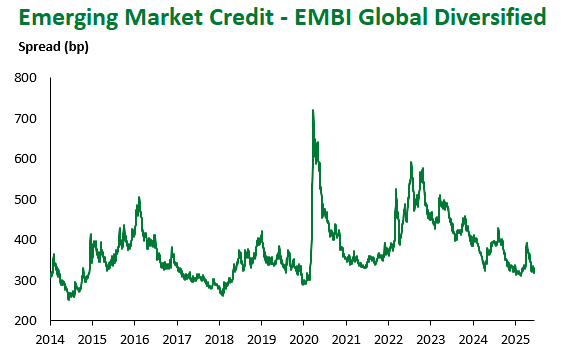


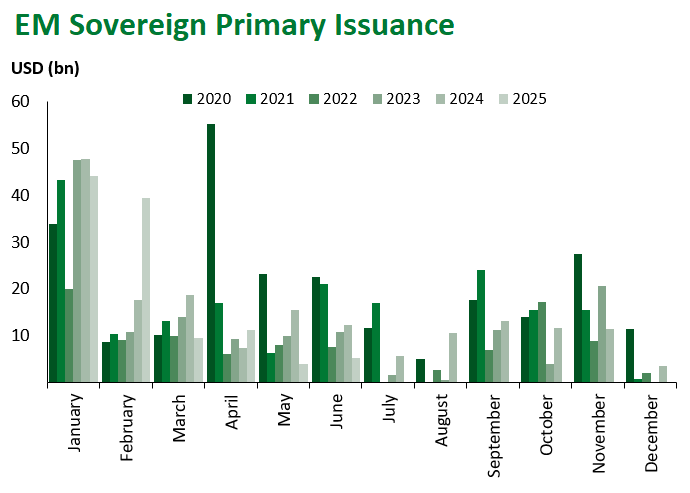
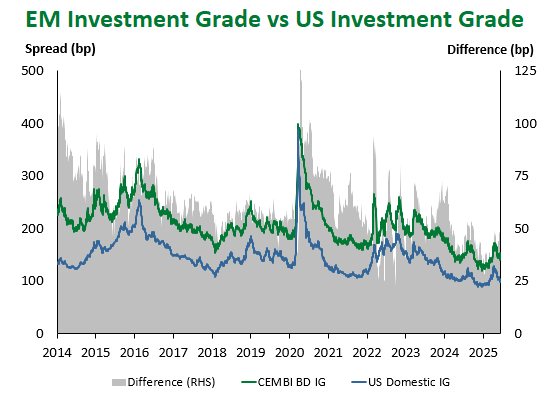

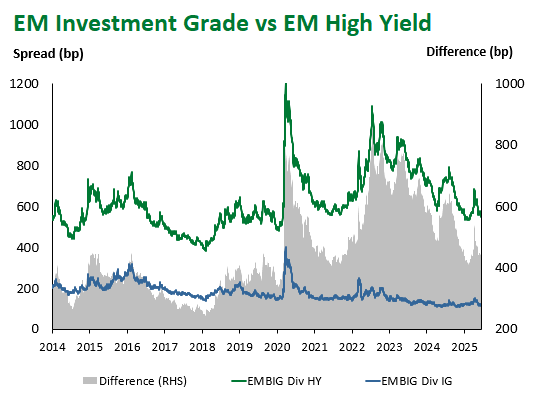

Emerging Markets Flows
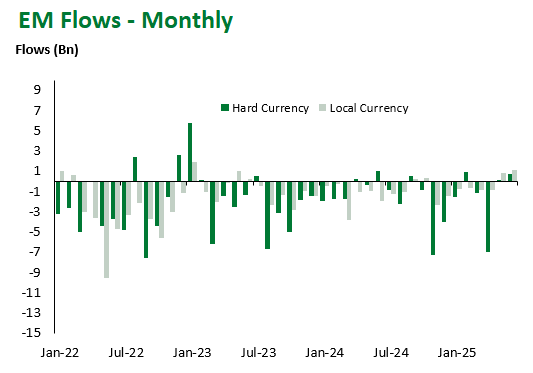
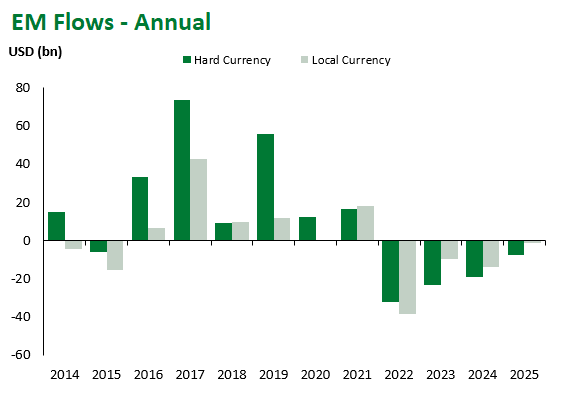
Source for graphs: Bloomberg, JPMorgan, Gramercy. As of June 13, 2025.
For questions, please contact:
Kathryn Exum, CFA ESG, Director, Co-Head of Sovereign Research, [email protected]
Petar Atanasov, Director, Co-Head of Sovereign Research, [email protected]
This document is for informational purposes only. The information presented is not intended to be relied upon as a forecast, research or investment advice, and is not a recommendation, offer or solicitation to buy or sell any securities or to adopt any investment strategy. Gramercy may have current investment positions in the securities or sovereigns mentioned above. The information and opinions contained in this paper are as of the date of initial publication, derived from proprietary and nonproprietary sources deemed by Gramercy to be reliable, are not necessarily all-inclusive and are not guaranteed as to accuracy. This paper may contain “forward-looking” information that is not purely historical in nature. Such information may include, among other things, projections and forecasts. There is no guarantee that any forecasts made will come to pass. Reliance upon information in this paper is at the sole discretion of the reader. You should not rely on this presentation as the basis upon which to make an investment decision. Investment involves risk. There can be no assurance that investment objectives will be achieved. Investors must be prepared to bear the risk of a total loss of their investment. These risks are often heightened for investments in emerging/developing markets or smaller capital markets. International investing involves risks, including risks related to foreign currency, limited liquidity, less government regulation, and the possibility of substantial volatility due to adverse political, economic or other developments. References to any indices are for informational and general comparative purposes only. The performance data of various indices mentioned in this update are updated and released on a periodic basis before finalization. The performance data of various indices presented herein was current as of the date of the presentation. Please refer to data returns of the separate indices if you desire additional or updated information. Indices are unmanaged, and their performance results do not reflect the impact of fees, expenses, or taxes that may be incurred through an investment with Gramercy. Returns for indices assume dividend reinvestment. An investment cannot be made directly in an index. Accordingly, comparing results shown to those of such indices may be of limited use. The information provided herein is neither tax nor legal advice. Investors should speak to their tax professional for specific information regarding their tax situation.
